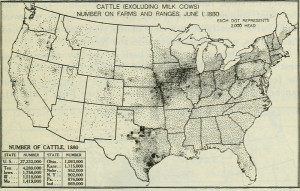Fleischner, T.L. 1994. Ecological Costs of Livestock Grazing in Western North America. Conservation Biology 8(3): 629-644.
One peer-reviewed journal article that is frequently cited by those who advocate removing all livestock grazing from public land is Fleischner (1994). The article is presented as a review of the scientific literature on livestock grazing in the West.
I’d like to put the article above in context. It was published in 1994, around the time some environmentalists we repeating; “Cattle free by 1993.” The statement was made in reference to removing livestock grazing from all federal public land. That did not happen and Fleischner was published in 1994. In addition, the review is over twenty-years-old. Isn’t there a more recent review that can be cited to make the case all or most livestock grazing is harmful to arid rangelands in the West?
In his article, Fleischner does not discriminate between over-grazing and sustainable grazing. He makes this clear in his letter to the editor in the April 1995 issue of Conservation Biology. In his letter he states: “I explained (Fleischner 1994) why I think the term “overgrazing” lacks clarity; consequently, I think the term should be avoided. I agree that there are valid uses of livestock as a management tool, but as I stated in the article (p. 636), many such claims are suspect.”
In terms of sustainable rangeland management, scientists and managers distinguish between over-grazing and sustainable grazing. To label papers about over-grazing, which is usually made clear in the introduction or objectives of an article, as a grazing study is misleading to the reader. I agree that over-grazing is not a sustainable practice and detrimental to any grazing land.
After Fleischner (1994) was published, at least 11 letters to the editor were published in the 1995 April and June issues of Conservation Biology about his review. Some supported Fleischner’s (1994) stance on the livestock grazing. While others stated his paper’s obvious bias “livestock grazing is detrimental” does not belong in a peer-reviewed scientific journal.
In addition, not all scientists agreed with the completeness of Fleischner (1994). Curtain in 2002 reported “A paper by Fleischner (1994) is not discussed here because that paper is generally not considered a comprehensive review of the literature (Brussard et al. 1994; Brown and McDonald 1995; Curtain 1995; Jones 2000).”
Below I present either quotes or summaries from the articles cited above:
Brown and McDonald (1995): “We have three concerns about this review.”
“First, it implicitly assumes that these studies reflect the average impact of grazing and thus its true costs. Examination of the relevant studies, however, reveals that some studies that report little or no livestock impact are not cited. Many studies that are cited suffer from poor experimental design. For example, many studies had problems with pseudo replication or lack of replication. Many study areas were likely chosen because differences between grazed and ungrazed areas were already apparent.”
“Second, many effects of excluding domestic livestock on other organisms and on ecological processes that Fleischner cited have also been observed when native mammals, ranging from rodents to mega herbivores, have been excluded. Such differences between plots where herbivorous mammals are present or absent are often substantial. Both domestic livestock and native mammalian herbivores may remove substantial biomass causing reduced herbaceous and shrubby plant cover, changes in plant and animal species composition, soil disturbance, and alteration of ecosystem processes, but these changes are not necessarily unnatural or detrimental.”
“Third, Fleischner repeats the fiction that the condition of western North America as chronicled by European explorers and colonists represents a natural and inherently desirable state. Changes in landscapes, habitats, and organisms recorded in the last few centuries are measured against an inferred historical condition and usually are regarded as detrimental impacts of human activities. In the absence of direct evidence such as photographs or fossils, determining with certainty past conditions and therefore a natural state, which has often fluctuated much through time, is difficult.” Note: References were deleted from the passage above due to length.
Brussard et al. (1994): While, I can’t find a reference to Fleischner in the article above. The editorial refutes the idea of scientists designing experiments to support the causes of environmental activists.
Curtin (1995): “I was disturbed by Fleischner’s failure to distinguish between overgrazing and grazing as a management tool. His review of the literature leads one to the implicit assumption that all grazing is bad.”
“…grazing has diverse and varied effects on the local biota.”
“Models by Milchunas et al. (1988) illustrate that one must consider grazing in the context of historical disturbances.”
“There is little doubt that overgrazing is a severe ecological problem. Yet, ecologically responsible grazing can be an important management tool for conservationists.”
Jones 2000: “Traditional qualitative literature reviews do little to resolve such controversial issues, as they are subject to biases of the reviewer. For example, Fleischner’s (1994) review of effects of grazing in western North America almost exclusively cites prior studies demonstrating detrimental effects of grazing. A range scientist with a contrary bias could easily cite as many studies demonstrating insignificant, and beneficial, effects of grazing. Though Fleischner’s study sought to make the case against grazing rather than present a comprehensive review of grazing literature, I cite this example to illustrate that literature reviews can sometimes be a front for specific agendas.”
References:
- Brown, J. H., and W. McDonald. 1995. Livestock grazing and conservation on southwestern rangelands. Conservation Biology 9:1644–1647.
- Brussard, P. F., D. D. Murphy, and C. R. Tracy. 1994. Cattle and conservation biology: another view. Conservation Biology 8: 919–921.
- Curtin, C. G. 1995. Grazing and advocacy. Conservation Biology 9:233–234.
- Jones, A. 2000. Effects of cattle grazing on North American arid ecosystems: a quantitative review. Western North American Naturalist 60:155–164.

